Abstract
1. In the present study, anaesthetized rats showed respiratory gasps (augmented breaths) at regular intervals during air breathing and at increased frequency during hypoxia (breathing 15, 12, 8 or 6% O2 in N2). Each augmented breath was accompanied by transient vasodilatation in hindlimb skeletal muscle and sometimes bradycardia. In hypoxia these changes were superimposed upon more gradual muscle vasodilatation and tachycardia. 2. Both the augmented breaths and the transient muscle vasodilatations disappeared immediately after bilateral vagotomy but both sometimes reappeared 1-2 h later, particularly in hypoxia. 3. The transient vasodilatation in skeletal muscle sometimes preceded the augmented breath, indicating that the vasodilatation was not a reflex initiated by pulmonary stretch receptors secondary to the augmented breath. Moreover, hyperinflation of the lungs to 5-10 mmHg evoked the Breuer-Hering respiratory reflex but had no effect upon the cardiovascular variables. 4. Addition of SO2 (300-400 p.pm.) to the inspirate, which others have shown preferentially blocks pulmonary stretch receptors, abolished the Breuer-Hering reflex, but had no significant effect on baseline levels of muscle vascular conductance or heart rate during normoxia, nor on the gradual increases in these variables during hypoxia (8% O2). Moreover, augmented breaths still occurred during air breathing and during hypoxia, each being associated with transient muscle vasodilatation. 5. These results indicate that pulmonary stretch receptors have little reflex effect upon the cardiovascular system of the rat either in normoxia or hypoxia. Rather, we suggest that transient muscle vasodilatation and possibly bradycardia, as well as an augmented breath, are all part of a primary reflex, initiated by pulmonary irritant receptors, and facilitated by peripheral chemoreceptor stimulation, repetition of which is an integral part of the response to hypoxia.
Full text
PDF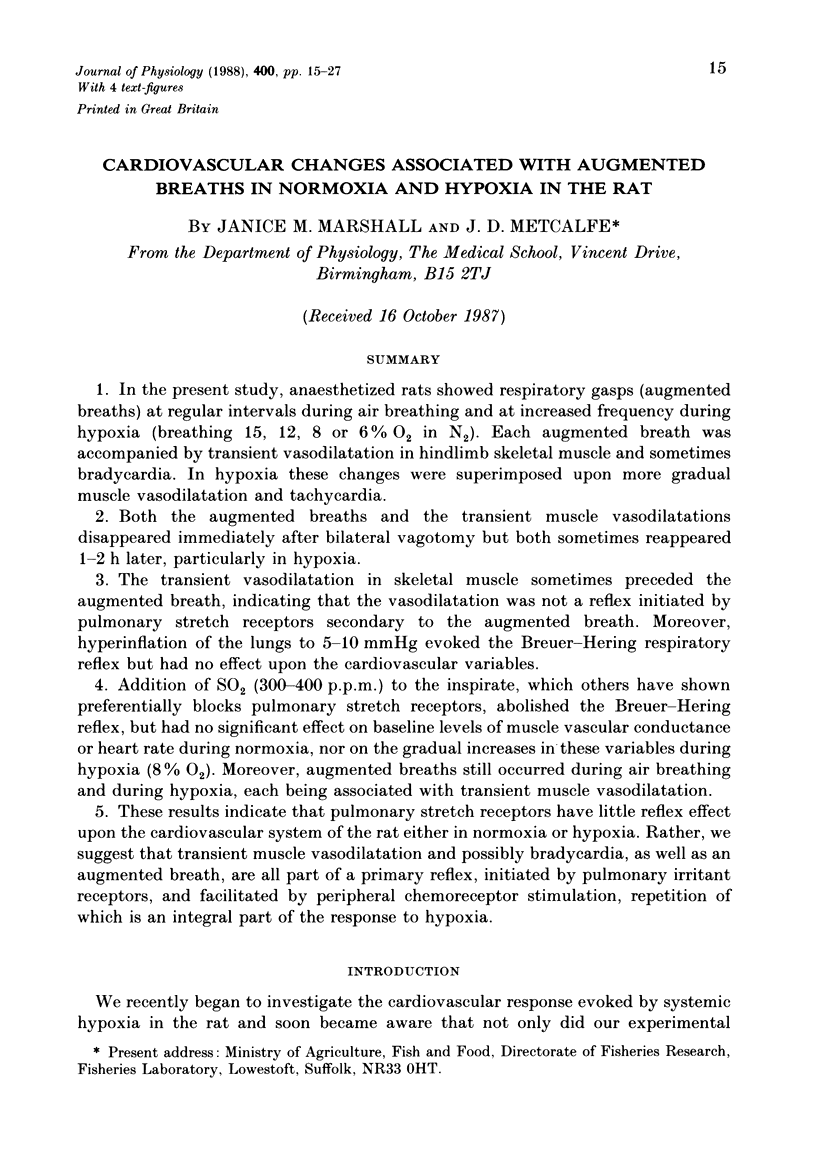
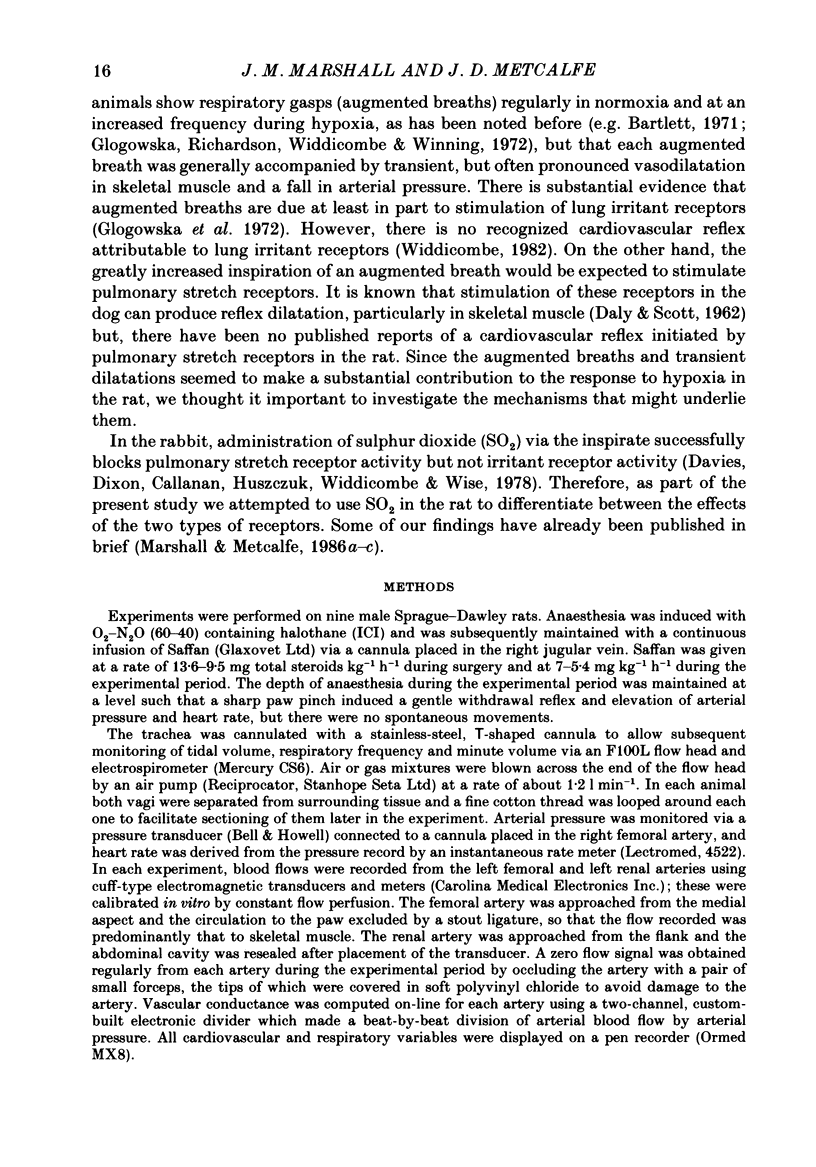

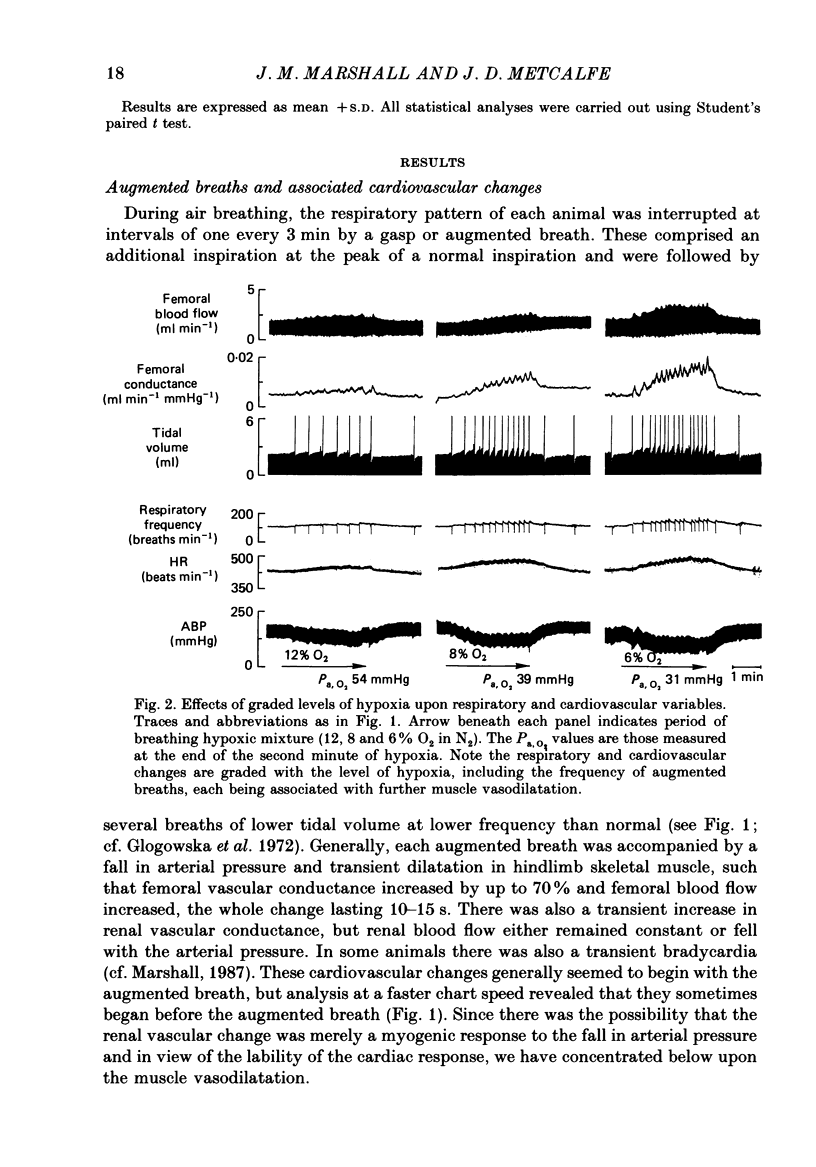

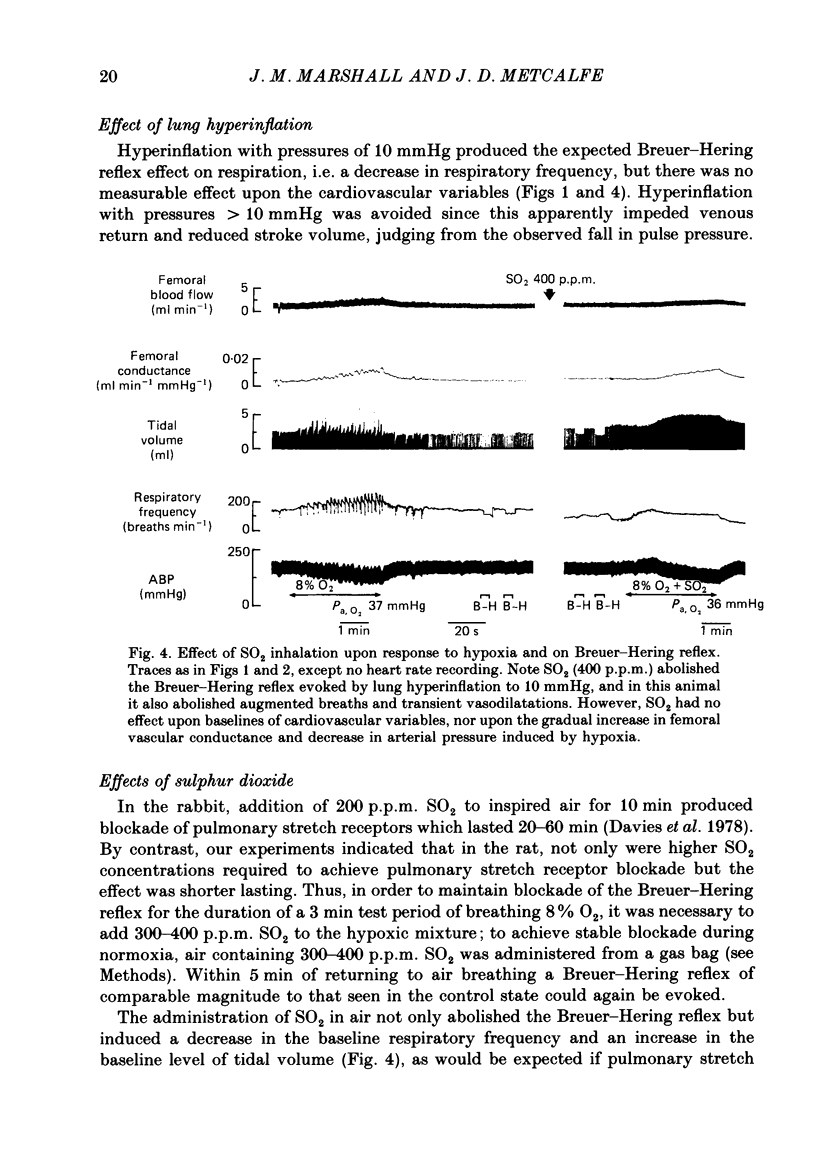
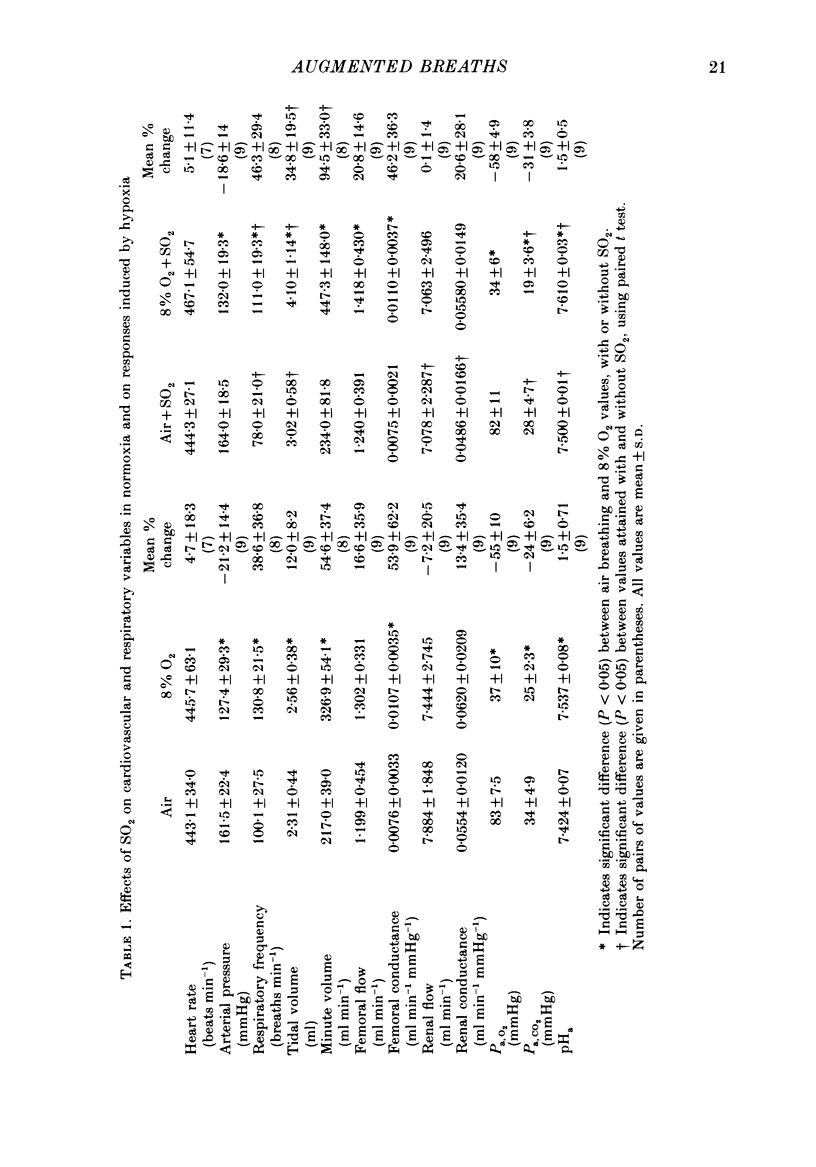
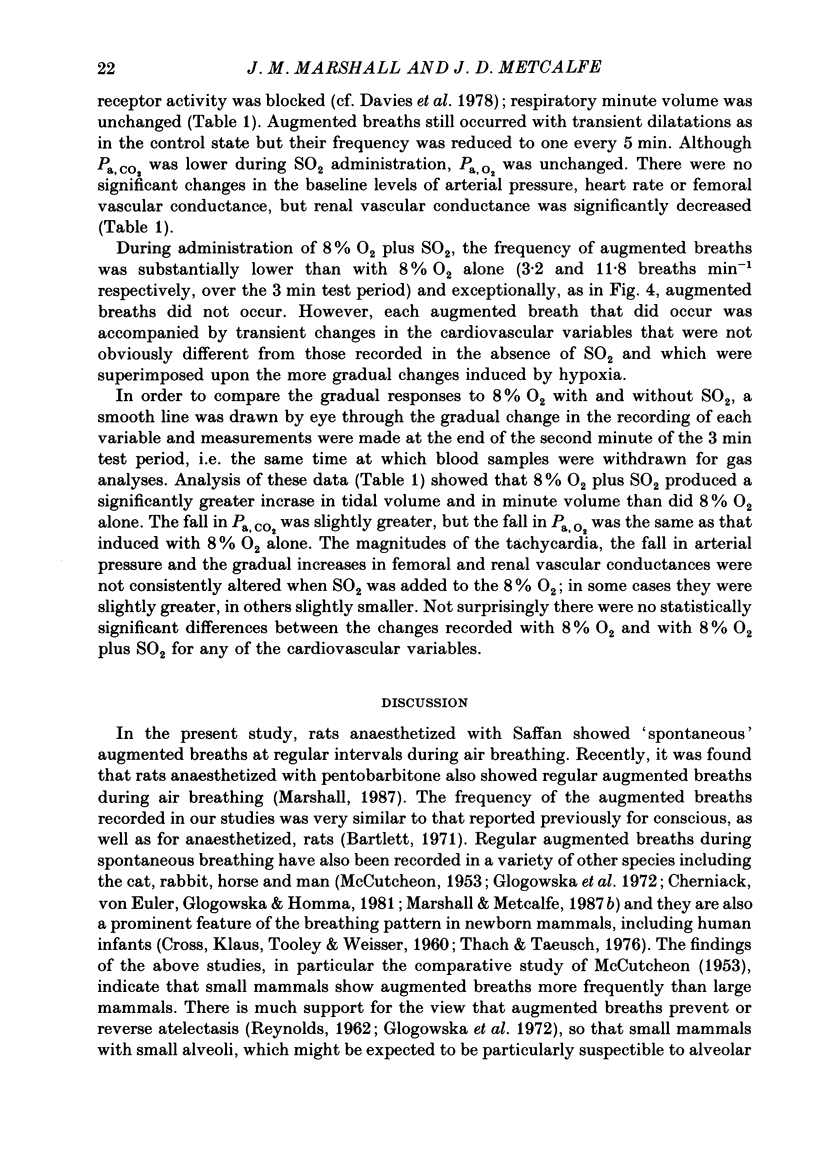
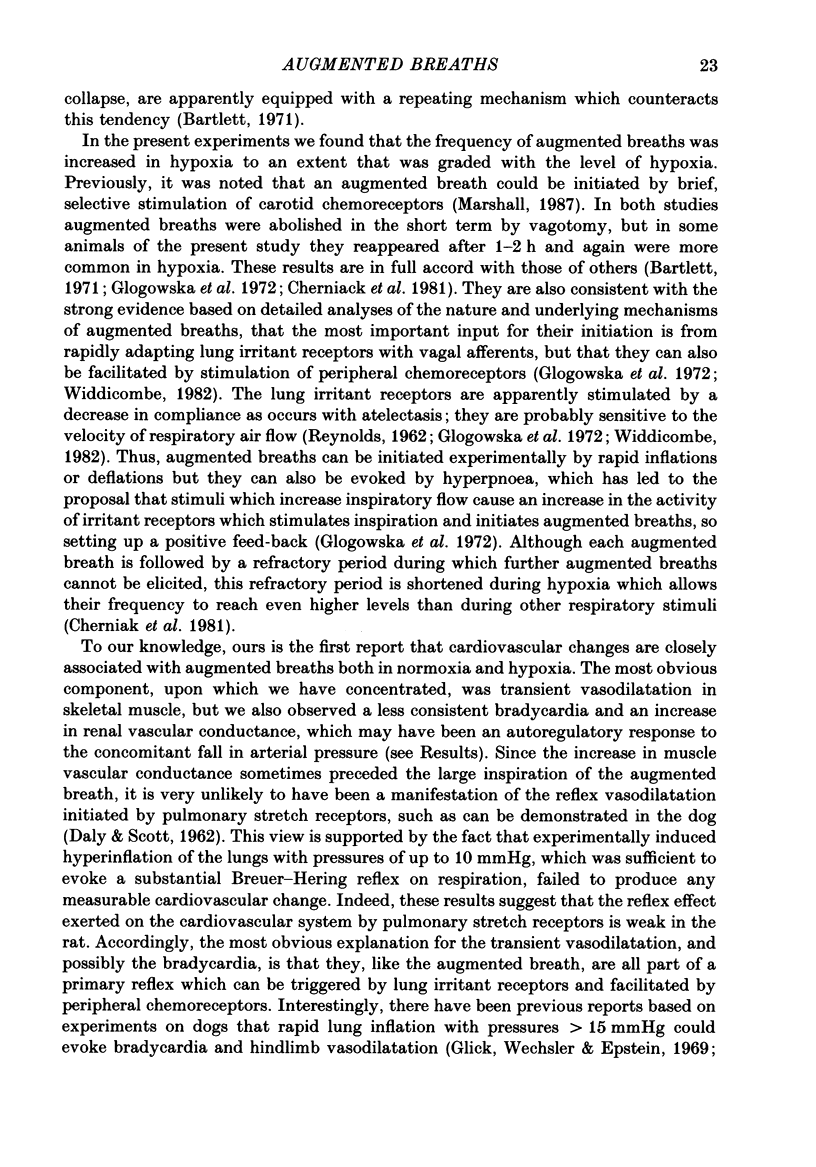
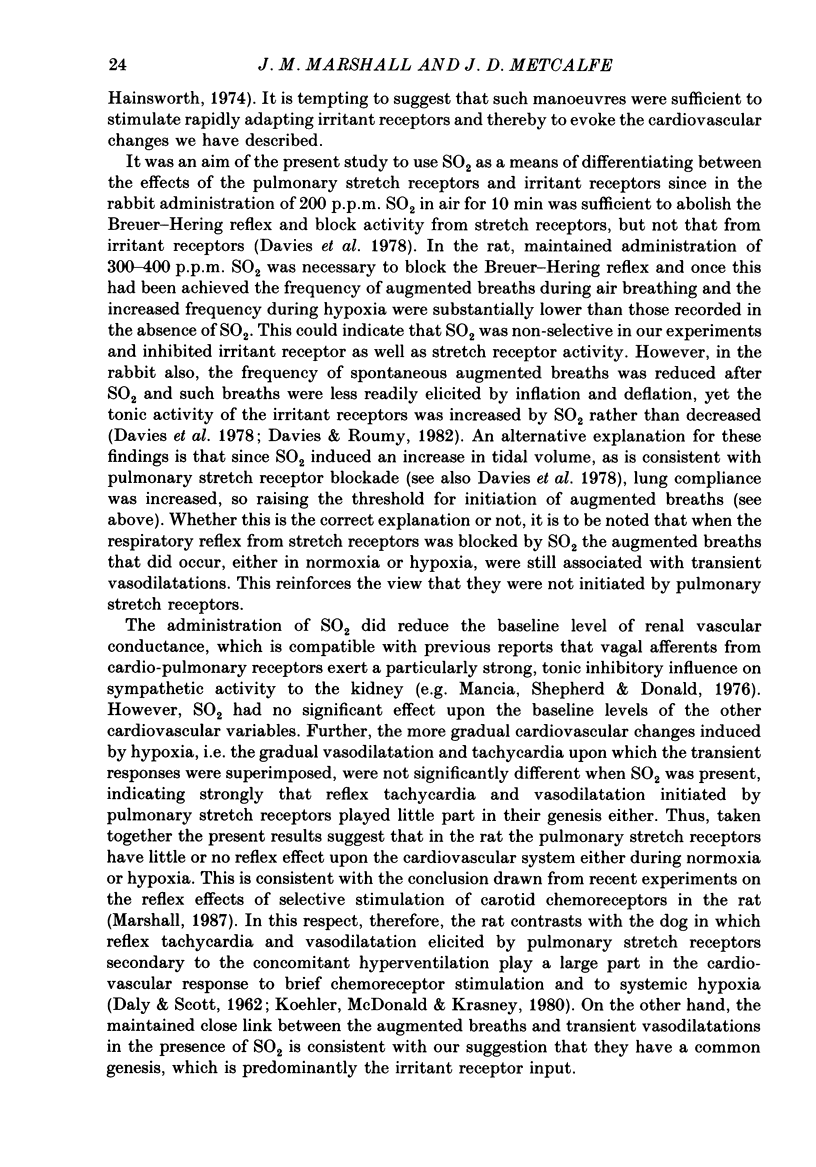
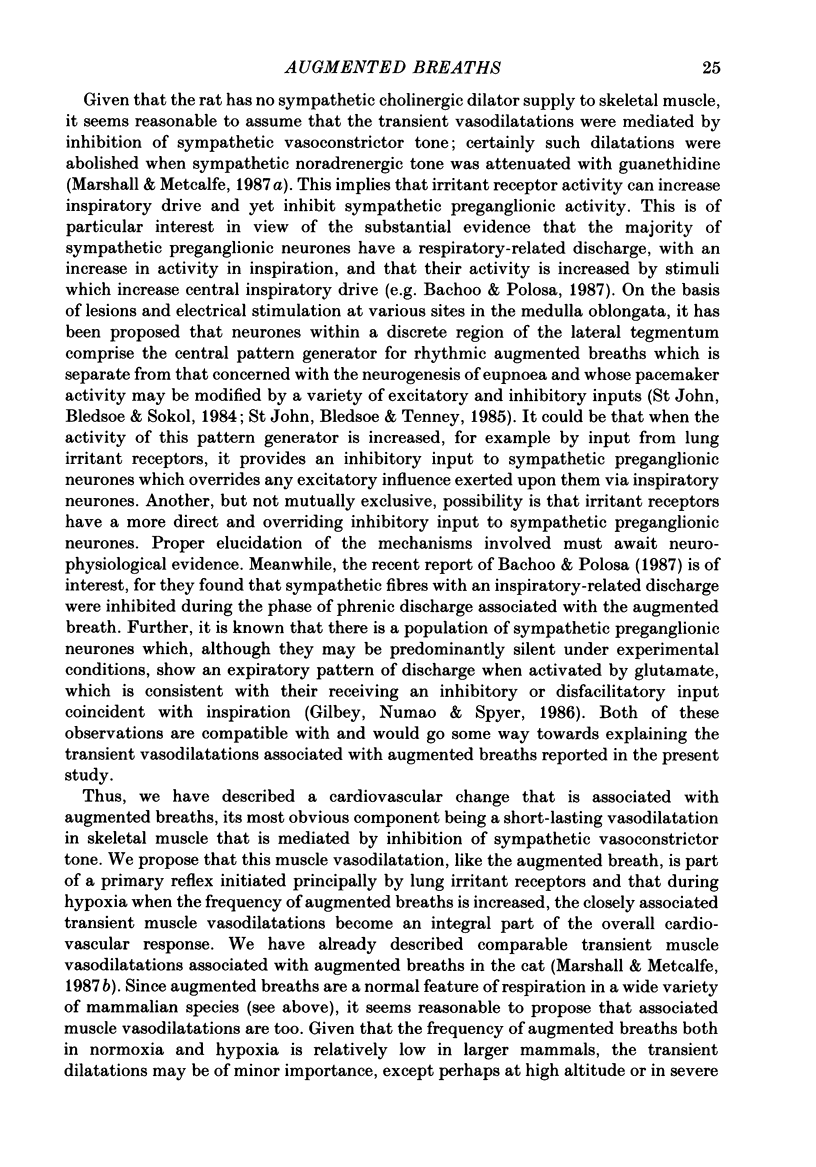
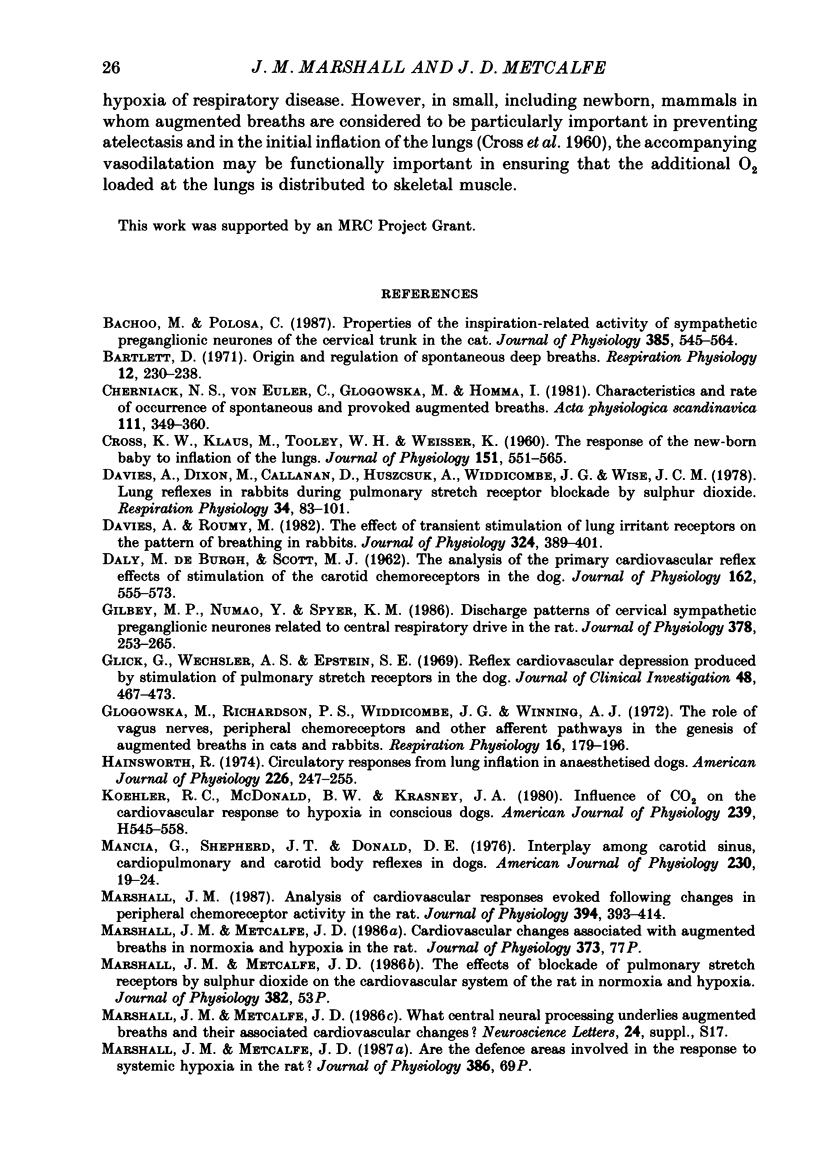
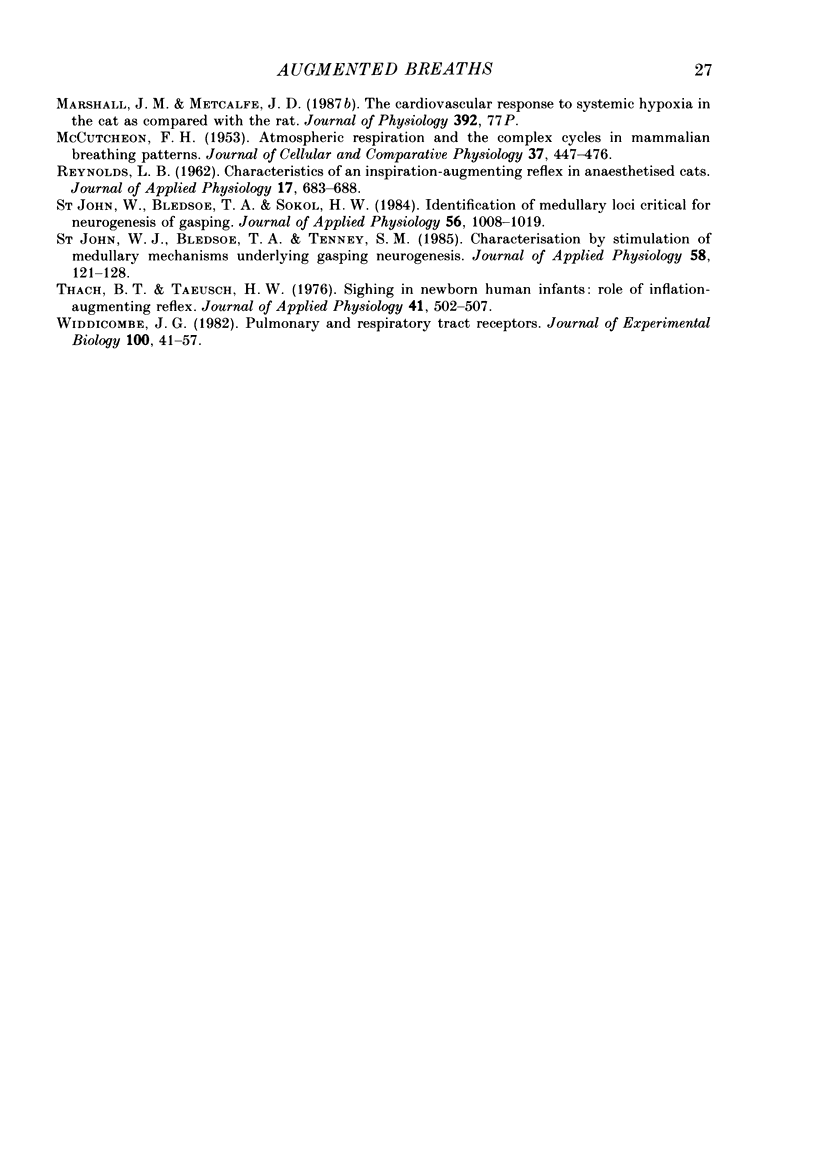
Selected References
These references are in PubMed. This may not be the complete list of references from this article.
- Bachoo M., Polosa C. Properties of the inspiration-related activity of sympathetic preganglionic neurones of the cervical trunk in the cat. J Physiol. 1987 Apr;385:545–564. doi: 10.1113/jphysiol.1987.sp016507. [DOI] [PMC free article] [PubMed] [Google Scholar]
- Bartlett D., Jr Origin and regulation of spontaneous deep breaths. Respir Physiol. 1971 Jun;12(2):230–238. doi: 10.1016/0034-5687(71)90055-7. [DOI] [PubMed] [Google Scholar]
- CROSS K. W., KLAUS M., TOOLEY W. H., WEISSER K. The response of the new-born baby to inflation of the lungs. J Physiol. 1960 Jun;151:551–565. doi: 10.1113/jphysiol.1960.sp006459. [DOI] [PMC free article] [PubMed] [Google Scholar]
- Cherniack N. S., von Euler C., Głogowska M., Homma I. Characteristics and rate of occurrence of spontaneous and provoked augmented breaths. Acta Physiol Scand. 1981 Mar;111(3):349–360. doi: 10.1111/j.1748-1716.1981.tb06747.x. [DOI] [PubMed] [Google Scholar]
- DE BURGH DALY M., SCOTT M. J. An analysis of the primary cardiovascular reflex effects of stimulation of the carotid body chemoreceptors in the dog. J Physiol. 1962 Aug;162:555–573. doi: 10.1113/jphysiol.1962.sp006950. [DOI] [PMC free article] [PubMed] [Google Scholar]
- Davies A., Dixon M., Callanan D., Huszczuk A., Widdicombe J. G., Wise J. C. Lung reflexes in rabbits during pulmonary stretch receptor block by sulphur dioxide. Respir Physiol. 1978 Jul;34(1):83–101. doi: 10.1016/0034-5687(78)90050-6. [DOI] [PubMed] [Google Scholar]
- Davies A., Roumy M. The effect of transient stimulation of lung irritant receptors on the pattern of breathing in rabbits. J Physiol. 1982 Mar;324:389–401. doi: 10.1113/jphysiol.1982.sp014119. [DOI] [PMC free article] [PubMed] [Google Scholar]
- Gilbey M. P., Numao Y., Spyer K. M. Discharge patterns of cervical sympathetic preganglionic neurones related to central respiratory drive in the rat. J Physiol. 1986 Sep;378:253–265. doi: 10.1113/jphysiol.1986.sp016218. [DOI] [PMC free article] [PubMed] [Google Scholar]
- Glick G., Wechsler A. S., Epstein S. E. Reflex cardiovascular depression produced by stimulation of pulmonary stretch receptors in the dog. J Clin Invest. 1969 Mar;48(3):467–473. doi: 10.1172/JCI106004. [DOI] [PMC free article] [PubMed] [Google Scholar]
- Glogowska M., Richardson P. S., Widdicombe J. G., Winning A. J. The role of the vagus nerves, peripheral chemoreceptors and other afferent pathways in the genesis of augmented breaths in cats and rabbits. Respir Physiol. 1972 Oct;16(2):179–196. doi: 10.1016/0034-5687(72)90050-3. [DOI] [PubMed] [Google Scholar]
- Hainsworth R. Circulatory responses from lung inflation in anesthetized dogs. Am J Physiol. 1974 Feb;226(2):247–255. doi: 10.1152/ajplegacy.1974.226.2.247. [DOI] [PubMed] [Google Scholar]
- Koehler R. C., McDonald B. W., Krasney J. A. Influence of CO2 on cardiovascular response to hypoxia in conscious dogs. Am J Physiol. 1980 Oct;239(4):H545–H558. doi: 10.1152/ajpheart.1980.239.4.H545. [DOI] [PubMed] [Google Scholar]
- Mancia G., Shepherd J. T., Donald D. E. Interplay among carotid sinus, cardiopulmonary, and carotid body reflexes in dogs. Am J Physiol. 1976 Jan;230(1):19–24. doi: 10.1152/ajplegacy.1976.230.1.19. [DOI] [PubMed] [Google Scholar]
- Marshall J. M. Analysis of cardiovascular responses evoked following changes in peripheral chemoreceptor activity in the rat. J Physiol. 1987 Dec;394:393–414. doi: 10.1113/jphysiol.1987.sp016877. [DOI] [PMC free article] [PubMed] [Google Scholar]
- REYNOLDS L. B., Jr Characteristics of an inspiration-augmenting reflex in anesthetized cats. J Appl Physiol. 1962 Jul;17:683–688. doi: 10.1152/jappl.1962.17.4.683. [DOI] [PubMed] [Google Scholar]
- St John W. M., Bledsoe T. A., Sokol H. W. Identification of medullary loci critical for neurogenesis of gasping. J Appl Physiol Respir Environ Exerc Physiol. 1984 Apr;56(4):1008–1019. doi: 10.1152/jappl.1984.56.4.1008. [DOI] [PubMed] [Google Scholar]
- St John W. M., Bledsoe T. A., Tenney S. M. Characterization by stimulation of medullary mechanisms underlying gasping neurogenesis. J Appl Physiol (1985) 1985 Jan;58(1):121–128. doi: 10.1152/jappl.1985.58.1.121. [DOI] [PubMed] [Google Scholar]
- Thach B. T., Taeusch H. W., Jr Sighing in newborn human infants: role of inflation-augmenting reflex. J Appl Physiol. 1976 Oct;41(4):502–507. doi: 10.1152/jappl.1976.41.4.502. [DOI] [PubMed] [Google Scholar]
- Widdicombe J. G. Pulmonary and respiratory tract receptors. J Exp Biol. 1982 Oct;100:41–57. doi: 10.1242/jeb.100.1.41. [DOI] [PubMed] [Google Scholar]


